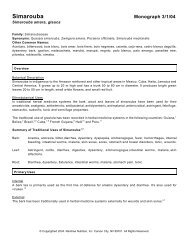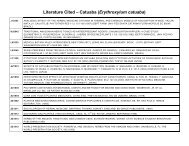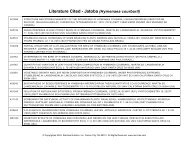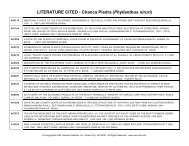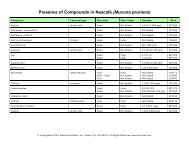Organ Specific Guide - Raintree Nutrition, Inc
Organ Specific Guide - Raintree Nutrition, Inc
Organ Specific Guide - Raintree Nutrition, Inc
You also want an ePaper? Increase the reach of your titles
YUMPU automatically turns print PDFs into web optimized ePapers that Google loves.
AMAZON BITTERS EXTRACT<br />
Description: People have long known about the benefits of digestive bitters to aid in digestive function<br />
and to increase digestive juices and bile production. This Amazon formula combines the rainforest's most<br />
bitter plants into one dynamic formula.<br />
Traditional uses by organ or system: Digestive Tract: To aid digestive function by increasing gastric<br />
secretions and bile production.<br />
Ingredients: A proprietary blend of simarouba (Simarouba amara), quinine (Cinchona officinalis), carqueja<br />
(Baccharis genistelloides), amargo (Quassia amara), and artichoke (Cynara scolymus) extracted in distilled<br />
water and 40% ethanol.<br />
Suggested Use: Take 30 drops (1 ml) directly by mouth 15 to 30 minutes before each meal.<br />
Contraindications: Not to be used during pregnancy or while breast-feeding.<br />
Drug Interactions: None reported.<br />
Other Practitioner Observations and Possible Precautions: None.<br />
Synopsis of research: (Please the online Tropical Plant Database for all cited research.)<br />
• Simarouba shares some of the same bitter quassinoid chemicals as quinine and amargo. These bitter<br />
chemicals explain simarouba’s long standing traditional uses as a digestive stimulant and for many types<br />
of digestive complaints.<br />
• Quinine bark is still harvested today to make bitter tonic waters. Nearly half of the world harvest of<br />
quinine bark is directed to the food industry for the production of quinine water, tonic water, and as an<br />
FDA-approved bitter food additive. In traditional medicine systems around the world, quinine has been<br />
used for centuries as a digestive stimulant, a bitter tonic and appetite stimulant, and for a wide range of<br />
digestive complaints.<br />
• Carqueja is described in Brazilian herbal medicine systems as having the therapeutic properties of a<br />
tonic, bitter, febrifuge, and stomachic, with cited uses for dyspepsia, gastroenteritis, liver diseases,<br />
diarrhea and ileocecal valve disorders. In laboratory studies, carqueja has evidenced antiulcerous,<br />
antacid, stomachic, gastrotonic, hepatotonic, and antihepatotoxic actions. Carqueja’s antacid, antiulcer,<br />
and hypotensive properties were documented in two Brazilian animal studies in 1992. Its antiulcer and<br />
analgesic properties were reported in a 1991 clinical study that showed that carqueja reduced gastric<br />
secretions and had an analgesic effect in rats with H. pylori ulcers. That study concluded that carqueja<br />
"may relieve gastrointestinal disorders by reducing acid secretion and gastrointestinal hyperactivity." A<br />
later study, in 2000, confirmed its antiulcerogenic effect when a water extract of carqueja administered<br />
to rats protected them from alcohol-induced ulcers.<br />
• Amargo bark contains many active constituents including bitter principles reported to be 50 times more<br />
bitter than quinine. While amargo contains many of the same types of antimalarial chemicals as quinine<br />
bark, it also contains another chemical called quassin. The large amount of quassin in the bark and wood<br />
gives amargo a bitterness rating of 40,000. In herbal medicine systems in South America, amargo is<br />
employed as a bitter digestive aid to stimulate gastric and other digestive secretions as well as for<br />
dyspepsia, fevers, tuberculosis, kidney stones and gallstones. In research in 2002, amargo was shown<br />
to have antiulcerous actions in mice, inhibiting the formation of gastric ulcers (induced by stress and<br />
various chemical means).<br />
• Artichoke is popular for its pleasant bitter taste, which is attributed mostly to a plant chemical called<br />
cynarin found in the green parts of the plant. Cynarin is considered one of artichoke's main biologically<br />
active chemicals. It occurs in the highest concentration in the leaves of the plant, which is why leaf<br />
extracts are most commonly employed in herbal medicine. Cynarin and/or artichoke has been<br />
documented by research to have antihepatotoxic, antioxidant, chologogue, choleretic, hepatoprotective,<br />
hepatotonic, and hypocholesterolemic actions.



